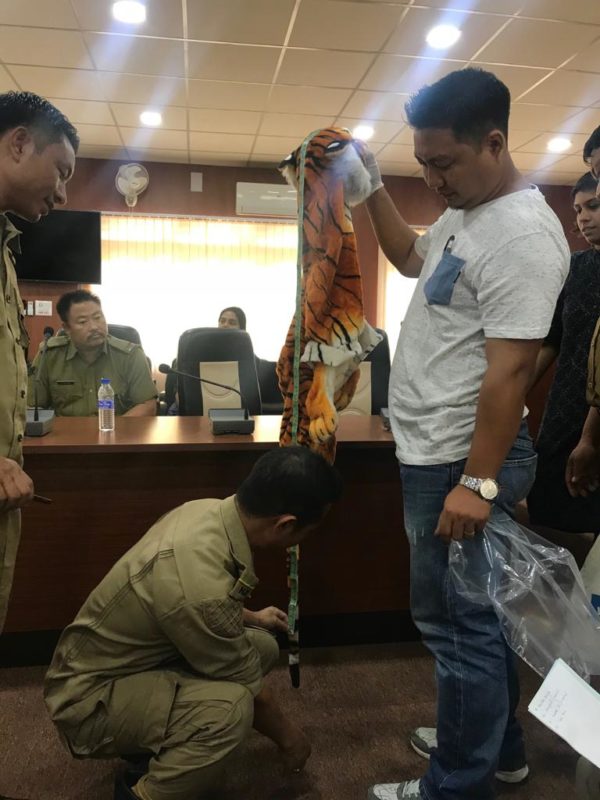Debangini Ray wasn’t expecting any work call over a weekend, and certainly not one from a high-ranking officer in security forces. However, the urgency of the call became overt soon.
The officer was reaching out after his team had received intelligence about Tokay geckos in a house near a village in Assam. His team was at the spot and had discovered that the geckos were to be smuggled across the Bhutan border. However, none of the officers were experienced enough to handle the case.
Debangini, coordinator of Counter Wildlife Trafficking (CWT) program with Wildlife Conservation Society (WCS)-India, came to the officer’s rescue and put him in touch with Wildlife Crime Control Bureau and Forest Department officials. Soon, the geckos were taken into custody by the Forest Department and a Preliminary Offence Report (POR) was registered. The team also filed a request to the local court, seeking permission to release the geckos in the wild or to hand them over to a zoo. The case is currently under investigation.
“The officer was a part of CWT helpline program,” informed Debangini.
Technology to the rescue
CWT helpline program is an initiative by WCS-India, to curb wildlife trafficking and to ensure conviction in such cases. The program, currently active in eight states - Assam, Meghalaya, Nagaland, Telangana, Jharkhand, West Bengal, Manipur and Mizoram, is supporting and guiding over 600 officials across various agencies, who can crack the whip on wildlife trafficking.
WCS-India staff recreating a wildlife crime scenario during a workshop
“The helpline is a part of our capacity building workshop conducted for officials from Forest Departments, Customs Department and security forces of India. The idea is to enhance the capacity of frontline staff to detect, investigate, prosecute and convict wildlife traffickers. Capacity building is done through training and workshop, followed up by technical assistance through the helpline,” said Sahila Kudalkar, program manager, CWT.
The helpline guides officials on species’ identification and legal and procedural question around trafficking cases. It also ensures continuous conversation around wildlife trafficking with the help of daily updates.
“We segregate and divide the information into small infographics or posts with visuals and videos and send these messages to the officers, on a daily basis. The posts can include information on commonly smuggled wildlife species, level of protection accorded under Wild Life Protection Act, 1972, information on body parts used by traffickers and investigation tips. Quizzes, revolving around workshop material are posted too,” says Debangini.
Gearing up to combat wildlife crime
The helpline updates officials on current news items related to wildlife trafficking, connects officers with pro bono lawyers and provides continuous on-call assistance.
“Apart from serving as a tool, facilitating continuous interaction with officers trained in the workshops, we also ensure that they get on-call assistance, as and when needed. We help them with legal recourse and material to take up a case and then share the news with us and other officials,” said Aditi Rajan, member, CWT.
Officers from Jharkhand Forest Department attending one of the workshops organized WCS-IndiaWhile various organizations are working at the grassroots level, interacting with communities and raising awareness on wildlife trafficking, WCS’s CWT program is one of its kind. The program focuses on officers who are equipped to take action.
Currently, the team is handling 28 groups of 650 officials from various departments across eight states, and this number is expected to grow in coming months. “The program will soon start in Maharashtra, Goa, Andhra Pradesh, Telangana, Karnataka, Tamil Nadu and Kerala. We are also looking at, training of the trainers. We will soon identify promising officers and will equip them with skills and knowledge, so that they can go ahead and become trainers for their respective departments,” informed Sahila.
Beneficiaries Speak
When Asish Kelwar joined the Chhattisgarh Forest Department as an assistant conservator, he was taken aback by high number of wild boars’ killing cases. According to Ashish, the boars are killed by villagers for meat consumption, sometimes using explosives in food as bait. The villagers wrap the explosive material in a cloth along with food and use it as a bait. When the wild boars get attracted by the food, they bite on the cloth bundle which explodes, killing or maiming them.
“I wanted to take up these cases and thus collected some meat and blood sample from local market. I sent the sample to a forensic lab in Raipur, but they declined the request saying they did not have the facility for such testing. That is when WCS helpline came into picture and I was informed that such tests are done at Wildlife Institute of India, Dehradun. Through the helpline, I also got to know about the right ways to collect, pack and transport the samples,” says Ashish, who attended the workshop in March 2019, and has been using the helpline since then.

Participants at one of the CWT workshops being trained in sample identification
Ankit Kumar, a Central Reserve Police Force officer, is yet another beneficiary, who attended the workshop recently and is looking forward to using the information. “I had no idea that offenses against wildlife is punishable. The workshop made me aware about various aspects of The Wildlife Protection Act, 1972. Now, I know how to go about a wildlife trafficking case. The workshop has given me the confidence to tackle such cases and I am looking forward to using the helpline too,” says Ankit.
It should be noted that multiple governments are taking the fight against wildlife crime seriously. For example, Assam government has established fast track courts to hear wildlife cases and has enhanced punishments for offences under the WLPA. Security agencies are also upping the fight against wildlife crime by seizing large numbers of tokay geckos being smuggled across the borders. The WCS-India’s CWT team is honoured to assist these Government enforcement officers and agencies in their fight against illegal wildlife trafficking.
Written by Garima Prasher